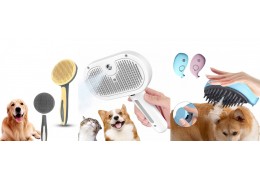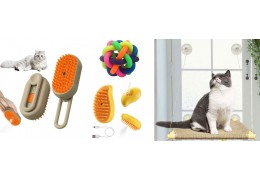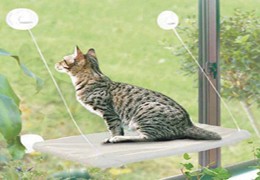Overfeeding is a common but serious issue that can lead to obesity, diabetes, and digestive problems in pets. This...
DIY Dog Grooming: How to Keep Your Pup Looking Great at Home
Grooming your dog at home is a rewarding and cost-effective way to maintain their health and appearance. With the right tools, such as dog clippers nails, a dog hair blower dryer, and a quality brush dog brush, you can achieve professional-level grooming results without leaving your home. Regular grooming keeps your dog’s coat healthy, prevents skin issues, and helps you bond with your furry friend. This guide will show you how to groom your dog step by step and recommend the best tools to make the process smooth and stress-free.
Why DIY Dog Grooming is Worth It?
Professional grooming services can be expensive, especially for breeds that require frequent maintenance. Learning how to groom your dog at home saves money and gives you greater control over your pet’s comfort and hygiene. It also allows you to check for skin issues, parasites, and abnormal growths that may require veterinary attention.
Essential Tools for DIY Dog Grooming
To groom your dog effectively at home, you’ll need a few key tools.
1. Dog Clippers Nails
Trimming your dog’s nails regularly prevents painful overgrowth and reduces the risk of injury. Long nails can cause discomfort when walking and may lead to joint issues if left unchecked.
Features to Look For:
• Sharp Blades: Ensure clean cuts to avoid splitting.
• Safety Guard: Prevents cutting the quick, reducing the risk of bleeding.
• Comfortable Grip: Reduces hand fatigue during trimming.
2. Dog Hair Blower Dryer
A dog hair blower dryer is essential for drying your dog’s coat after a bath, especially for breeds with thick or double coats. Air drying can lead to matting and prolonged dampness, which can cause skin infections.
Why You Need It:
• Speeds Up Drying: Ideal for dogs with dense coats.
• Prevents Mats: Keeps fur smooth and manageable.
• Reduces Shedding: Blows out loose fur, minimizing shedding between grooming sessions.
3. Brush Dog Brush
Brushing is a critical part of dog grooming. A high-quality brush dog brush helps remove loose fur, detangle knots, and distribute natural oils, keeping your dog’s coat shiny and healthy.
Types of Brushes:
• Slicker Brushes: Ideal for long-haired breeds and dogs prone to matting.
• Bristle Brushes: Best for short-haired breeds to remove loose fur and dirt.
• Undercoat Rakes: Useful for double-coated breeds to reduce shedding.
Step-by-Step Guide to Grooming Your Dog at Home
Step 1: Brushing and Detangling
Start by brushing your dog’s coat to remove loose fur and prevent tangles. A brush dog brush designed for your dog’s coat type will make this process easier.
How to Brush:
• Brush in the direction of hair growth to avoid discomfort.
• Focus on areas prone to matting, such as behind the ears, under the legs, and around the tail.
• Use an undercoat rake if your dog has a double coat to remove loose fur from the underlayer.
Frequency:
• Short-haired dogs: Once a week.
• Long-haired dogs: Every 2-3 days.
• Double-coated breeds: Several times a week, especially during shedding season.
Step 2: Bathing Your Dog
Bathing helps remove dirt, debris, and odors from your dog’s coat. Use a dog-specific shampoo that matches your dog’s coat type and skin sensitivity.
Tips for a Successful Bath:
• Lukewarm Water: Ensure the water is not too hot or cold.
• Massage Shampoo Gently: Work it into the coat to remove dirt and oils.
• Rinse Thoroughly: Avoid leaving residue that can irritate the skin.
Step 3: Drying with a Dog Hair Blower Dryer
Once your dog is clean, it’s time to dry their coat. Using a dog hair blower dryer ensures the fur dries quickly, preventing mats and skin issues.
How to Use:
• Start on Low Heat: To avoid burning sensitive skin.
• Keep the Nozzle Moving: Prevent overheating any one area.
• Brush While Drying: Helps remove loose fur and prevent tangles.
Step 4: Trimming with Dog Clippers Nails
Trimming your dog’s nails is essential to prevent pain and injury. Overgrown nails can lead to misaligned joints and discomfort.
How to Trim:
• Use a Steady Hand: Hold the paw gently but firmly.
• Trim Small Amounts: Avoid cutting too close to the quick.
• Check Nail Length: Ensure the nails are short enough without touching the ground.
Step 5: Trimming Fur as Needed
Some dogs require regular fur trimming, especially around the face, paws, and tail. If your dog has areas prone to matting, keeping the fur shorter in these regions will prevent discomfort.
Tools to Use:
• Scissors for Precision: Ideal for trimming around the face and ears.
• Dog Clippers: Useful for maintaining an even coat length.
Step 6: Final Brushing and Inspection
After drying and trimming, give your dog one final brush to remove loose fur and distribute oils. Check for any skin abnormalities, parasites, or signs of irritation.
Grooming Tips for a Stress-Free Experience
1. Start Early: Introduce grooming to your dog when they are young to make it a positive experience.
2. Use Treats: Reward your dog after each grooming session to build positive associations.
3. Be Patient: Go slow, especially if your dog is nervous or uncooperative.
4. Take Breaks: If your dog becomes stressed, take breaks and resume when they are calm.
Choosing the Right Tools for DIY Grooming
Finding the Best Dog Clippers Nails
Look for clippers that provide precise cutting and have safety guards to prevent over-cutting. Some of the best dog clippers nails come with ergonomic designs that reduce hand fatigue and offer better control.
Picking a Reliable Dog Hair Blower Dryer
A powerful dog hair blower dryer should offer adjustable heat and speed settings to accommodate different coat types. Choose models with quiet motors to avoid stressing your dog.
Selecting the Right Brush Dog Brush
Different breeds require different brushes. Choose a brush dog brush that suits your dog’s coat type to prevent pulling and irritation.
Benefits of Regular Home Grooming
1. Saves Money: Eliminates frequent visits to professional groomers.
2. Strengthens Bond: Grooming sessions create positive bonding experiences.
3. Early Detection of Health Issues: Spotting skin problems or abnormalities early prevents serious issues.
4. Keeps Your Home Cleaner: Regular grooming reduces shedding and keeps your living space fur-free.
Common Mistakes to Avoid
• Skipping Brushing Before Bathing: Mats and tangles become harder to remove when wet.
• Using Human Products: Human shampoos and conditioners can irritate a dog’s skin.
• Rushing Nail Trims: Cutting too quickly can lead to bleeding and pain.
Conclusion
Grooming your dog at home can be a rewarding and stress-free experience with the right tools and techniques. By investing in dog clippers nails, a reliable dog hair blower dryer, and a quality brush dog brush, you can keep your pup looking great while maintaining their health. Regular grooming not only improves your dog’s appearance but also strengthens your bond and ensures their overall well-being.
With consistency and patience, you’ll become a pro at DIY dog grooming in no time. Start today and enjoy the satisfaction of keeping your furry friend looking and feeling their best!













Top authors